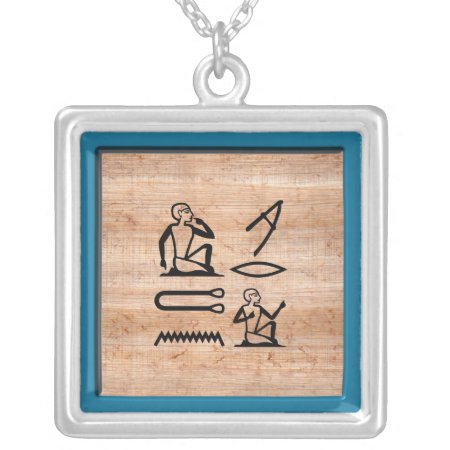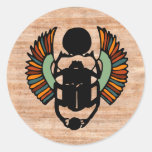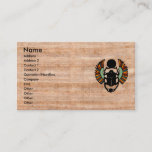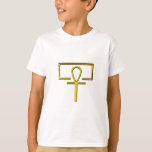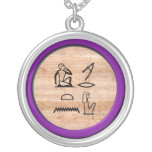Egyptian "i Love You" (man To Woman) Silver Plated Necklace
By Headbees
Egyptian "i Love You" (man To Woman) Silver Plated Necklace
Fully customizable Egyptian "I Love You" (Man to Woman) Silver Plated Necklace created by HEADBEES. Personalize this product with your own text and images (if the design allows it) and create a gift for yourself, a loved one, for your event or your business. Product Type Zazzle Necklace. Style Large. Color Category Silverplate.
Tell the special woman in your life, "I love you," in Ancient Egyptian. Although vowels cannot be pronounced with certainty, it's roughly pronounced "Murah ah ten." The pronouns represent a man speaking to a woman. Deliver this necklace with a matching valentine. Or choose another color or style. Ancient Egypt was an ancient civilization of Northeastern Africa, concentrated along the lower reaches of the Nile River in what is now the modern country of Egypt. Egyptian civilization coalesced around 3150 BC (according to conventional Egyptian chronology) with the political unification of Upper and Lower Egypt under the first pharaoh. The history of ancient Egypt occurred in a series of stable Kingdoms, separated by periods of relative instability known as Intermediate Periods: the Old Kingdom of the Early Bronze Age, the Middle Kingdom of the Middle Bronze Age and the New Kingdom of the Late Bronze Age. Egypt reached the pinnacle of its power during the New Kingdom, in the Ramesside period, after which it entered a period of slow decline. Egypt was conquered by a succession of foreign powers in this Late Period. In the aftermath of Alexander the Great's death, one of his generals, Ptolemy Soter, established himself as the new ruler of Egypt. This Ptolemaic Dynasty ruled Egypt until 30 BC, when it fell to the Roman Empire and became a Roman province. The success of ancient Egyptian civilization came partly from its ability to adapt to the conditions of the Nile River Valley. The predictable flooding and controlled irrigation of the fertile valley produced surplus crops, which fueled social development and culture. With resources to spare, the administration sponsored mineral exploitation of the valley and surrounding desert regions, the early development of an independent writing system, the organization of collective construction and agricultural projects, trade with surrounding regions, and a military intended to defeat foreign enemies and assert Egyptian dominance. Motivating and organizing these activities was a bureaucracy of elite scribes, religious leaders, and administrators under the control of a Pharaoh who ensured the cooperation and unity of the Egyptian people in the context of an elaborate system of religious beliefs. The many achievements of the ancient Egyptians include the quarrying, surveying and construction techniques that facilitated the building of monumental pyramids, temples, and obelisks; a system of mathematics, a practical and effective system of medicine, irrigation systems and agricultural production techniques, the first known ships, Egyptian faience and glass technology, new forms of literature, and the earliest known peace treaty. Egypt left a lasting legacy. Its art and architecture were widely copied, and its antiquities carried off to far corners of the world. Its monumental ruins have inspired the imaginations of travellers and writers for centuries. A new-found respect for antiquities and excavations in the early modern period led to the scientific investigation of Egyptian civilization and a greater appreciation of its cultural legacy. The ancient Egyptians viewed men and women, including people from all social classes except slaves, as essentially equal under the law, and even the lowliest peasant was entitled to petition the vizier and his court for redress. Both men and women had the right to own and sell property, make contracts, marry and divorce, receive inheritance, and pursue legal disputes in court. Married couples could own property jointly and protect themselves from divorce by agreeing to marriage contracts, which stipulated the financial obligations of the husband to his wife and children should the marriage end. Compared with their counterparts in ancient Greece, Rome, and even more modern places around the world, ancient Egyptian women had a greater range of personal choices and opportunities for achievement. Women such as Hatshepsut and Cleopatra VI even became pharaohs, while others wielded power as Divine Wives of Amun. Despite these freedoms, ancient Egyptian women did not often take part in official roles in the administration, served only secondary roles in the temples, and were not as likely to be as educated as men. Also see a BBC History article online for more information on gender equality in ancient Egypt. Hieroglyphic writing dates from c. 3000 BC, and is composed of hundreds of symbols. A hieroglyph can represent a word, a sound, or a silent determinative; and the same symbol can serve different purposes in different contexts. Hieroglyphs were a formal script, used on stone monuments and in tombs, that could be as detailed as individual works of art. In day-to-day writing, scribes used a cursive form of writing, called hieratic, which was quicker and easier. While formal hieroglyphs may be read in rows or columns in either direction (though typically written from right to left), hieratic was always written from right to left, usually in horizontal rows. A new form of writing, Demotic, became the prevalent writing style, and it is this form of writing—along with formal hieroglyphs—that accompany the Greek text on the Rosetta Stone.
The Most Popular Gifts By Headbees | ||
|---|---|---|
|
|
|
Pink Pity Party Mug.. $15.80 |
|
|
|
|
|
|
|
|
|
|
|
|
Browse this Designer's Gallery: All Products
Browse This Designer's Store at Zazzle: Most Popular
